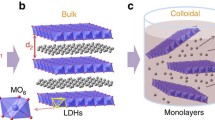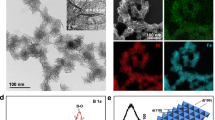Abstract
Two-dimensional catalysis is a very active research area in recent years. Water splitting catalysis may be achieved with the outstanding efficiency of the nickel oxyhydroxide (NiOOH) catalyst. NiOOH is a layered material, which constitutes of partially hydrogenated nickel oxide (NiO2) layers that are stacked together with the possible intercalation of water and electrolyte species. Recently, various studies have reported that NiO single sheets could be prepared and exhibit interesting photocatalytic properties. However, there is a lack of knowledge in developing efficient exfoliation processes adapted to such materials. We investigate with density functional theory the effect of intercalating cations, which is a strategy demonstrated recently to be efficient for exfoliation of various metal oxides. We observed that earth–alkali cations significantly increase the strength and amount of H bonds and inhibit exfoliation. Hence, we conclude that small alkali species are preferable for an exfoliation process of NiOOH.




Similar content being viewed by others
References
Zhou M, Lou XW, Xie Y (2013) Two-dimensional nanosheets for photoelectrochemical water splitting: Possibilities and opportunities. Nano Today 8(6):598–618
Chen HM, Chen CK, Liu R-S, Zhang L, Zhang J, Wilkinson DP (2012) Nano-architecture and material designs for water splitting photoelectrodes. Chem Soc Rev 41(17):5654
Deng D, Novoselov KS, Fu Q, Zheng N, Tian Z, Bao X (2016) Catalysis with two-dimensional materials and their heterostructures. Nat Nanotechnol 11(3):218–230
Siahrostami S, Tsai C, Karamad M, Koitz R, García-Melchor M, Bajdich M, Vojvodic A, Abild-Pedersen F, Nørskov JK, Studt F (2016) Two-dimensional materials as catalysts for energy conversion. Catal Lett 146:1917–1921. https://doi.org/10.1007/s10562-016-1837-z
Walton AS, Fester J, Bajdich M, Arman MA, Osiecki J, Knudsen J, Vojvodic A, Lauritsen JV (2015) Interface controlled oxidation states in layered cobalt oxide nanoislands on gold. ACS Nano 9(3):2445–2453
Sun Y, Gao S, Lei F, Xie Y (2015) Atomically-thin two-dimensional sheets for understanding active sites in catalysis. Chem Soc Rev 44(3):623–636
Bora DK, Braun A, Erni R, Müller U, Döbeli M, Constable EC (2013) Hematite–NiO/α-Ni(OH)2 heterostructure photoanodes with high electrocatalytic current density and charge storage capacity. Phys Chem Chem Phys 15(30):12648
Liang H, Li L, Meng F, Dang L, Zhuo J, Forticaux A, Wang Z, Jin S (2015) Porous two-dimensional nanosheets converted from layered double hydroxides and their applications in electrocatalytic water splitting. Chem Mater 27(16):5702–5711
Ida S, Ishihara T (2014) Recent progress in two-dimensional oxide photocatalysts for water splitting. J Phys Chem Lett 5(15):2533–2542
Trotochaud L, Boettcher SW (2014) Precise oxygen evolution catalysts: status and opportunities. Scr Mater 74:25–32
Van der Ven A, Morgan D, Meng YS, Ceder G (2006) Phase stability of nickel hydroxides and oxyhydroxides. J Electrochem Soc 153(2):A210–A215
Li YF, Selloni A (2014) Mechanism and activity of water oxidation on selected surfaces of pure and Fe-doped NiOx. ACS Catal 4(4):1148–1153
Naguib M, Gogotsi Y (2015) Synthesis of two-dimensional materials by selective extraction. Acc Chem Res 48(1):128–135
Yi M, Shen Z (2015) A review on mechanical exfoliation for the scalable production of graphene. J Mater Chem A 3(22):11700–11715
Yuan L, Ge J, Peng X, Zhang Q, Wu Z, Jian Y, Xiong X, Yin H, Han J (2016) A reliable way of mechanical exfoliation of large scale two dimensional materials with high quality. AIP Adv 6(12):125201
Ma R, Sasaki T (2015) Two-dimensional oxide and hydroxide nanosheets: controllable high-quality exfoliation, molecular assembly, and exploration of functionality. Acc Chem Res 48(1):136–143
Mas-Ballesté R, Gómez-Navarro C, Gómez-Herrero J, Zamora F (2011) 2D materials: to graphene and beyond. Nanoscale 3(1):20–30
Cheng Q, Yang T, Li Y, Li M, Chan CK (2016) Oxidation–reduction assisted exfoliation of LiCoO2 into nanosheets and reassembly into functional Li-ion battery cathodes. J Mater Chem A 4(18):6902–6910
Etman AS, Asfaw HD, Yuan N, Li J, Zhou Z, Peng F, Persson I, Zou X, Gustafsson T, Edström K, Sun J (2016) A one-step water based strategy for synthesizing hydrated vanadium pentoxide nanosheets from VO2 (B) as free-standing electrodes for lithium battery applications. J Mater Chem A 4(46):17988–18001
Lee S, Park H, Paik U, Han TH (2015) Exfoliation of titanium oxide powder into nanosheets using hydrothermal reaction and its reassembly into flexible papers for thin-film capacitors. J Solid State Chem 224:76–81
Liu L, Yao T, Tan X, Liu Q, Wang Z, Shen D, Sun Z, Wei S, Xie Y (2012) Room-temperature intercalation-deintercalation strategy towards VO2(B) single layers with atomic thickness. Small 8(24):3752–3756
Dudarev SL, Botton GA, Savrasov SY, Humphreys CJ, Sutton AP (1998) Electron-energy-loss spectra and the structural stability of nickel oxide: an LSDA + U study. Phys Rev B 57(3):1505–1509
Mavros MG, Tsuchimochi T, Kowalczyk T, Mcisaac A, Wang L, Van Voorhis T (2014) What can density functional theory tell us about artificial catalytic water splitting? Inorg Chem 53(13):6386–6397
Zaffran J, Toroker MC (2016) Benchmarking density functional theory based methods to model NiOOH material properties: Hubbard and van der Waals corrections vs hybrid functionals. J Chem Theory Comput 12(8):3807–3812
Zaffran J, Toroker MC (2016) Designing efficient doped NiOOH catalysts for water splitting with first principles calculations. ChemistrySelect 1(5):911–916
Zaffran J, Toroker MC (2016) Metal–oxygen bond ionicity as an efficient descriptor for doped NiOOH photocatalytic activity. ChemPhysChem 17(11):1630–1636. https://doi.org/10.1002/cphc.201600049
Fidelsky V, Butera V, Zaffran J, Toroker MC (2016) Three fundamental questions on one of our best water oxidation catalysts: a critical perspective. Theor Chem Acc 135:162. https://doi.org/10.1007/s00214-016-1915-8
Michael JD, Demeter EL, Illes SM, Fan Q, Boes JR, Kitchin JR (2015) Alkaline electrolyte and fe impurity effects on the performance and active-phase structure of NiOOH thin films for OER catalysis applications. J Phys Chem C 119(21):11475–11481
Zaffran J, Stevens MB, Trang CDM, Nagli M, Shehadeh M, Boettcher SW, Toroker MC (2017) Influence of electrolyte cations on Ni(Fe)OOH catalyzed oxygen evolution reaction. Chem Mater 29(11):4761–4767
Momma K, Izumi F (2008) A three-dimensional visualization system for electronic and structural analysis. J Appl Crystallogr 41:653–658
Henkelman G, Arnaldsson A, Jónsson H (2006) A fast and robust algorithm for Bader decomposition of charge density. Comput Mater Sci 36(3):354–360
Acknowledgements
This research was supported by the Nancy and Stephen Grand Technion Energy Program (GTEP) and the I-CORE Program of the Planning and Budgeting Committee, The Israel Science Foundation (Grant No. 152/11) and the SPIRA Fund for Applied Research in the Field of Energy. In addition, this research was supported by a grant from the Ministry of Science and Technology (MOST), Israel. This work was supported by the post Link-SCEEM-2 project, funded by the European Commission under the 7th Framework Program through the Capacities Research nfrastructure, INFRA-2010-1.2.3 Virtual Research Communities, Combination of Collaborative Project and Coordination and Support Actions (CP-CSA) under Grant Agreement No. RI-261600. J.Z. acknowledges the Israel Ministry of Aliyah and Immigrant Absorption, the Lady Davis and GTEP fellowships.
Author information
Authors and Affiliations
Corresponding author
Electronic supplementary material
Below is the link to the electronic supplementary material.
Rights and permissions
About this article
Cite this article
Zaffran, J., Nagli, M., Shehadeh, M. et al. Efficient cationic agents for exfoliating two-dimensional nickel oxide sheets. Theor Chem Acc 137, 3 (2018). https://doi.org/10.1007/s00214-017-2175-y
Received:
Accepted:
Published:
DOI: https://doi.org/10.1007/s00214-017-2175-y




